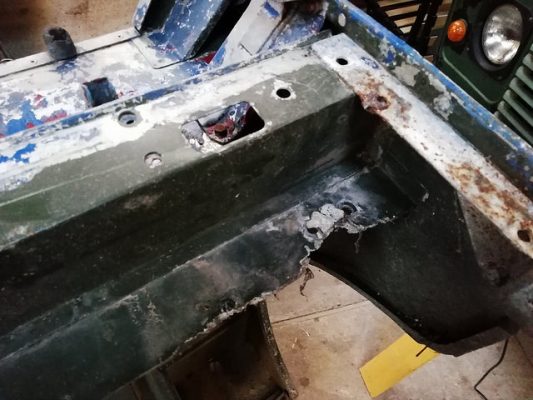A typical land rover rebuild requires a fair bit of rust busting. I think we’ve established that.
It’s not just the steel bits that rot though. While the aluminium panels (particularly the Birmabright on earlier vehicles) are more corrosion resistant than steel, they do corrode. This usually occurs where they are in contact with steel parts – a galvanic cell is created, which corrodes the aluminium parts. It’s basically a built in cathodic protection system, except the sacrificial bit is the bodywork. Nice.
This series 1 tub is no exception. The galvanic cell has done a good job of dissolving the rearmost panels of the tub at the rear crossmember mounts.
The damage is fairly local, so a local repair is feasible. This is good news, as a local repair will retain the ‘patina’ this vehicle has gained. This s1 is not going to be a shiny resto, so I can’t hide a new panel under a nice coat of paint.

The damaged area was cut out, and the surrounding metal cleaned of paint, grime, and oxides.

The reinforcing angle behind the panel was still in good condition.
A new piece of aluminium was cut to suit the gap. This is bog standard aluminium sheet from stock – probably 1100 grade. The original Birmabright alloy has been out of production for many, many years.

This repair piece needs to be butt welded to the existing panel. Aluminium can be a nuisance in sheet form like this, due to its unholy trinity of high thermal expansion, low melting temperature, and high thermal conductivity.
As far as aluminium body panel welding goes though, this example is about the best situation. It’s a relatively small repair piece, and the panel itself is quite small. Small means stiff, so less susceptible to warping.
Even with small repairs like this, care is required to prevent damage to the panel. Once tacked in place, the welds are laid bit by bit, allowing the panel to cool down a bit between welds. If the panel gets too hot, thermal expansion and end restraint will cause it to warp. If the material stays elastic, it should recover on cooling. If it’s a severe buckle, the material will yield and the panel will stay warped when it cools.
I used 5356 filler rods for this. I’ve heard about people cutting up old Birmabright panels into strips to use as filler, but I’ve not had any issues with 5356.

Normally I’m not one for smoothing welds out, but in this location it makes sense to flap it back to hide the repair.

Sorted. Just needs a wee bit of (sympathetic) attention with the airbrush. I’ll wait until there’s a few bits needing done, so the ‘finished’ pic can wait a while…
The front mounts were similarly crusty, so they got a similar treatment:



I don’t know how well aligned the outriggers on the chassis are, so I’ll leave drilling the front mount holes until I can do a test assembly of the bodywork on the chassis.
